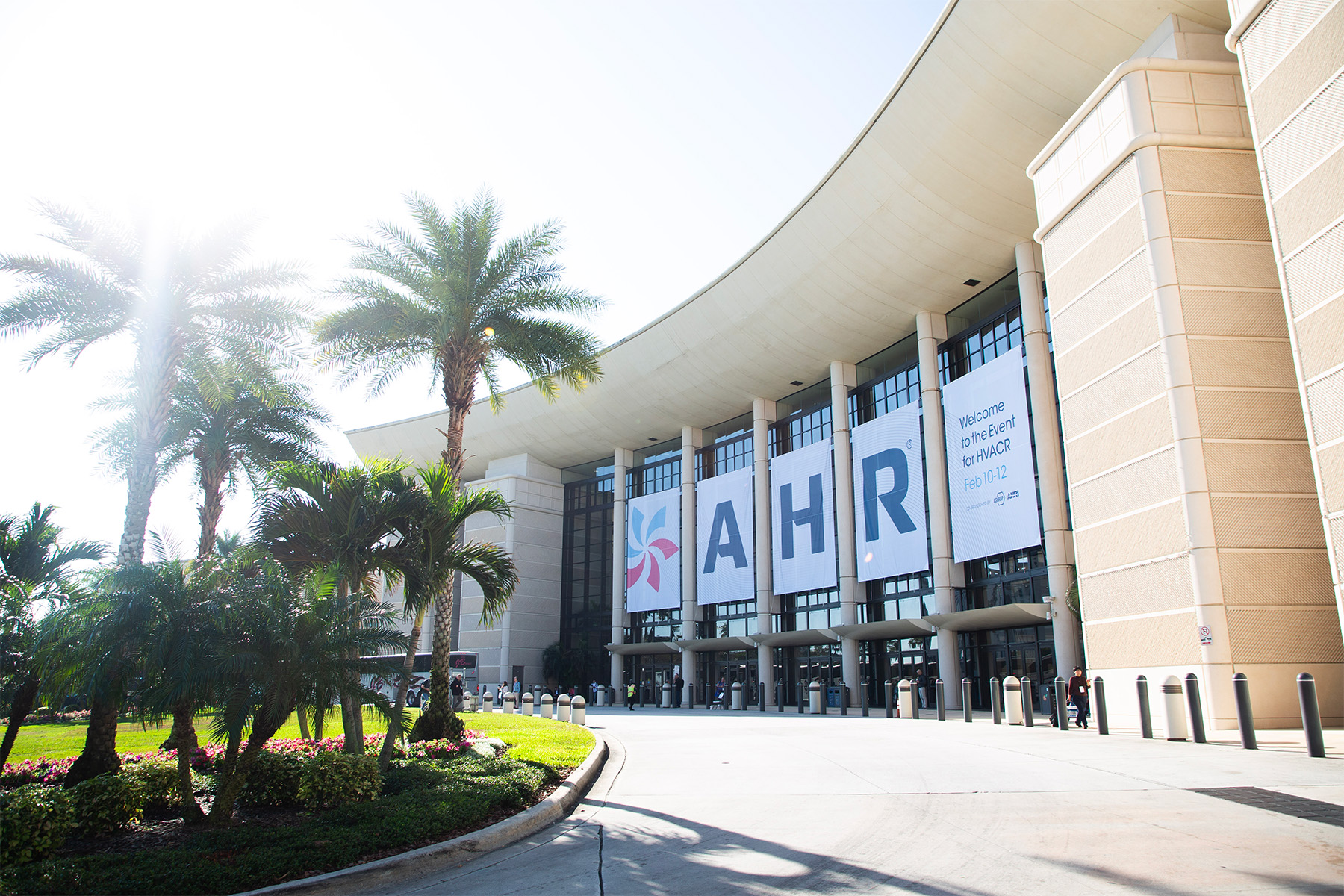
HVAC Technological Advancements Demonstrate Why The Future of Building Heat is Electric
Anyone attending AHR Expo, one of the nation’s largest Heating, Ventilation & Air Conditioning (HVAC) conferences, last month left with one big takeaway— heat pumps are so hot right now.
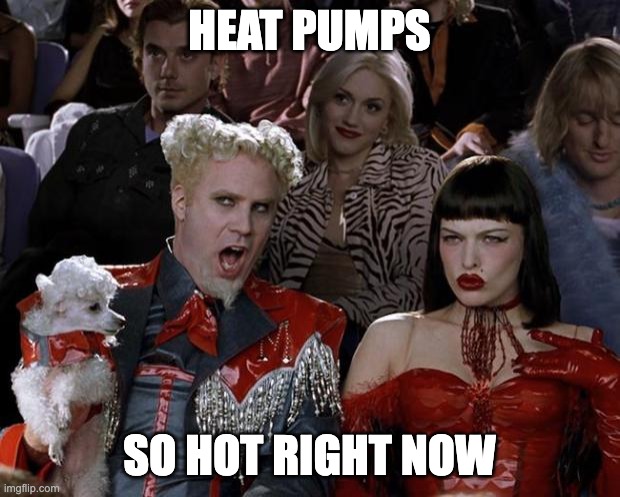
The show’s presentations and booths offered example after example of how the HVAC industry is decisively moving away from pollution-emitting technologies that use natural gas and other fossil fuels and toward zero-emission heat pump technologies that use electricity.
Practically every HVAC manufacturer at the show was promoting new heat pump product offerings. In addition, several manufacturers were touting heat pumps able to reliably and efficiently deliver heat to buildings located in the coldest regions in the United States. Company after company also described how they are working to integrate more environmentally friendly refrigerants in their products. And it seemed that wherever you looked, you could find HVAC manufacturers introducing innovative new heat pump water heaters, radiant heat, and thermal energy network products—products that will further expand the market for heat pump-related products or increase heat pumps’ performance advantages over fossil-fuel-powered furnaces.
Energy-Efficient Heat Pumps for America’s Coldest Climates
LG Electronics (LG) kicked off the AHR Expo with a press breakfast on the technological innovations they have integrated into one of their recently introduced heat pumps, which is designed for residential buildings located in cold climates.
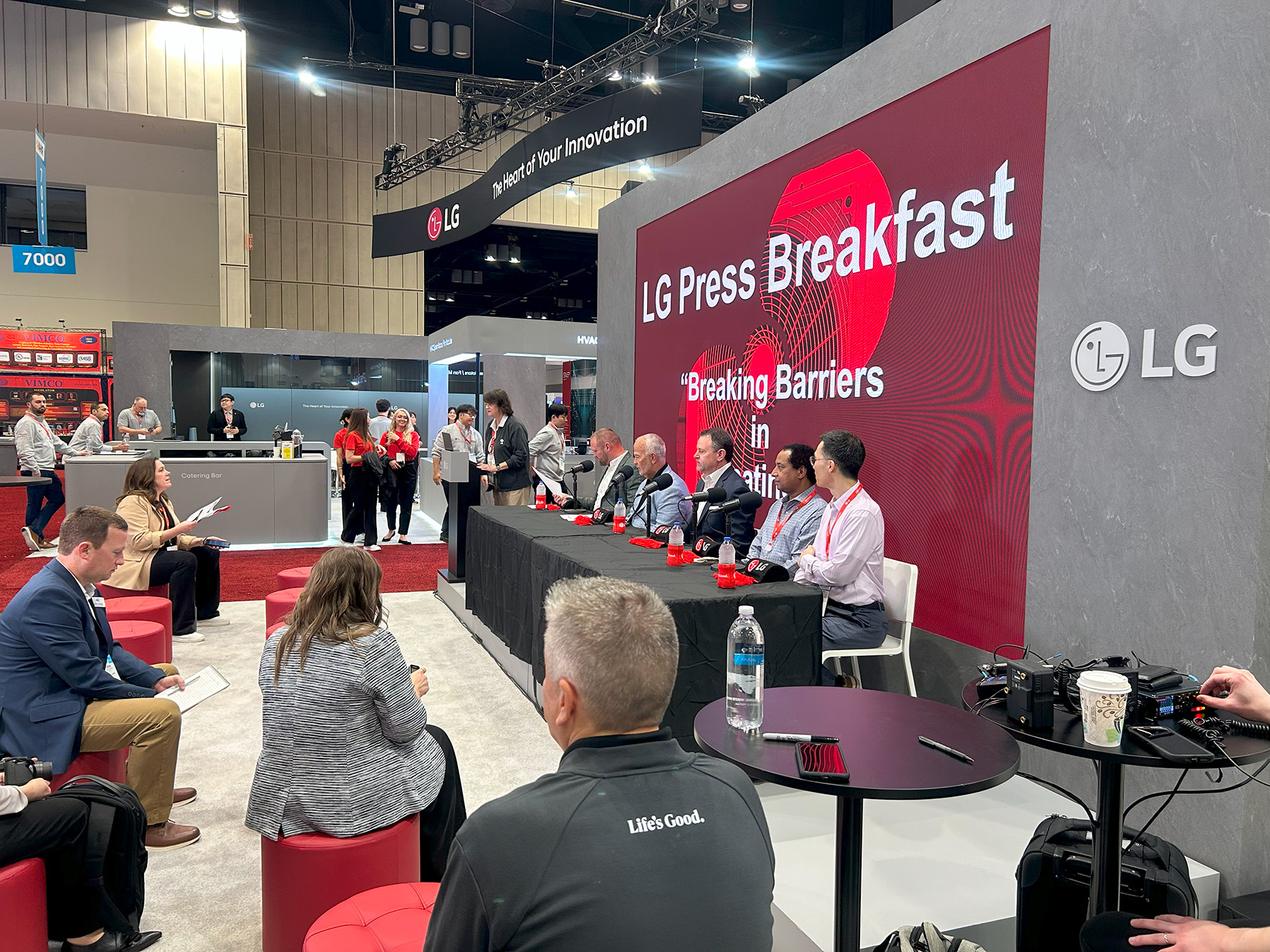
Caption: LG held a press breakfast looking at how they are “Breaking Barriers in Heating” with their new cold-climate heat pump
A winner of the 2025 AHR Innovation Award, this heat pump uses an advanced variable speed compressor, new kinds of refrigerant cycles, and high-efficiency twin rotary inverter compressors that enable it to effectively operate at as low as -35 degrees Celsius (-31 degrees Fahrenheit).
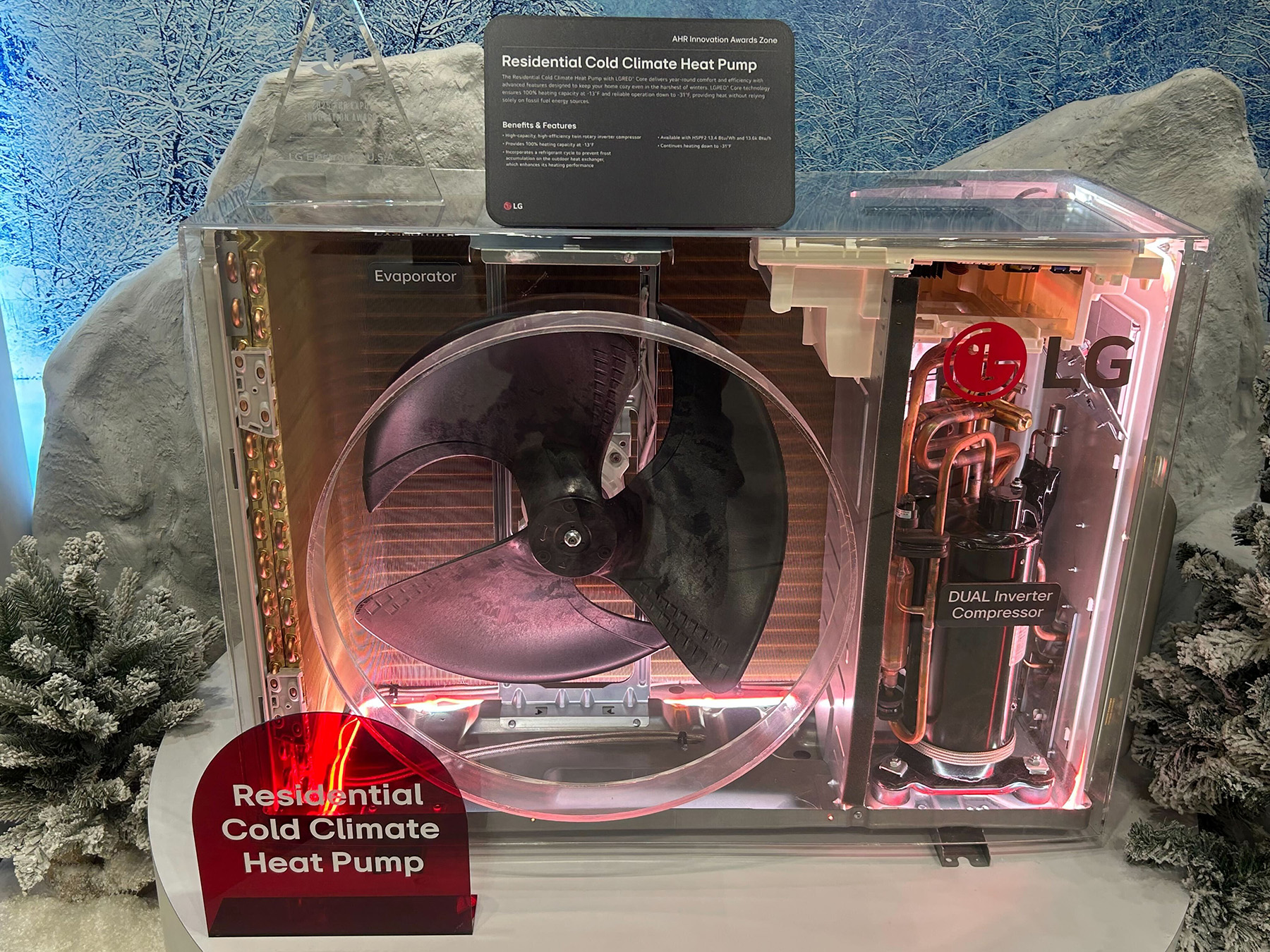
Caption: LG has integrated several innovative technologies into its recently introduced residential cold climate heat pump, enabling it to more efficiently and effectively heat buildings located in the coldest regions of the United States.
LG Senior VP Steve Scarbrough also spoke on a panel organized by LG on innovative design, during which he explained that heat pumps have come a long way from when they had a reputation for not operating well in cold climates. Since then, companies like LG have partnered with organizations like the University of Alaska in Fairbanks (who had some of their faculty on the panel as well) to conduct research on how heat pumps operate in cold climates. Manufacturers have used the insights delivered by this research to improve their heat pumps, enabling them to now work efficiently and effectively even when the mercury dips well below 0 degrees Fahrenheit. As a result, today, there are a wide variety of heat pumps on the market able to cost-effectively and reliably heat people’s homes in America’s coldest climates — as Maine’s rapid adoption of heat pumps demonstrates.
Industry Embraces Refrigerants with Lower Global Warming Potential
In addition to seeing many manufacturers touting new energy-efficient cold-climate heat pumps on the AHR Expo showroom floor, we also saw manufacturers highlighting how they are using, or plan to soon use, more climate-friendly refrigerants in their heat pump products. This is in response to regulations like the U.S. AIM Act, which requires the HVAC industry to integrate into their heat pump products refrigerants that have a lower global warming potential (GWP) than the HFC and HCFC refrigerants they have used in the past.
For example, Johnson Controls demonstrated how it will be using R32 and other low and ultra-low GWP refrigerants in its air handlers and other commercial HVAC products. Meanwhile, other manufacturers exhibited heat pumps that will use non-synthetic, ultra-low GWP refrigerant options, like R290 (propane) or R744 (CO2). For example, A.O. Smith plans to introduce a heat pump water heater in the fourth quarter of 2025 that uses CO2.
Technology Innovations Improve Heat Pump Performance and Expand the Heat Pump Market
Another trend we saw at the AHR Expo was manufacturers introducing products that make it easier for renters, Do-It-Yourselfers, apartment homeowners, and other types of customers to install a heat pump in their homes, offices, and other buildings.
For example, because until recently all heat pumps needed to be connected to 240-volt power outlets, many customers who only have 120-volt outlets in their house have been reluctant to install heat pumps, concerned about the costs and inconvenience of upgrading their electric panels to support 240-volt outlets. However, Midea showcased a 120-volt heat pump that can be installed in a windowsill. Midea’s heat pump uses a technology called enhanced vapor injection that increases the efficiency of a heat pump’s compressors.
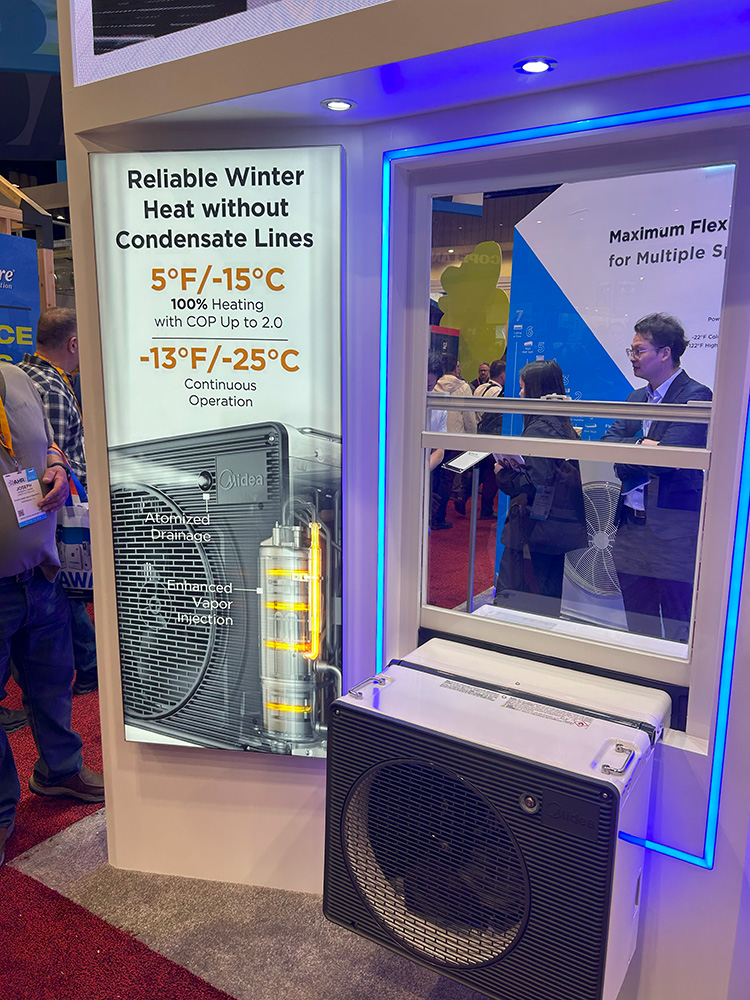
These and other 120-volt heat pumps (like Gradient’s) enable renters, low-to-moderate income homeowners, and millions of other customers who can’t afford to upgrade their home’s electric panels and wiring or whose landlords refuse to make this upgrade to install a heat pump.
Midea also introduced an air handler solution called the Air Cube. This type of air handler can be configured in multiple ways, making it easier for contractors to overcome installation obstacles when they need to move large volumes of air from a heat pump throughout a home. The air handler also features an M-coil that is more efficient than conventional A-coils and can act as an additional source of heat when needed in cold climates.
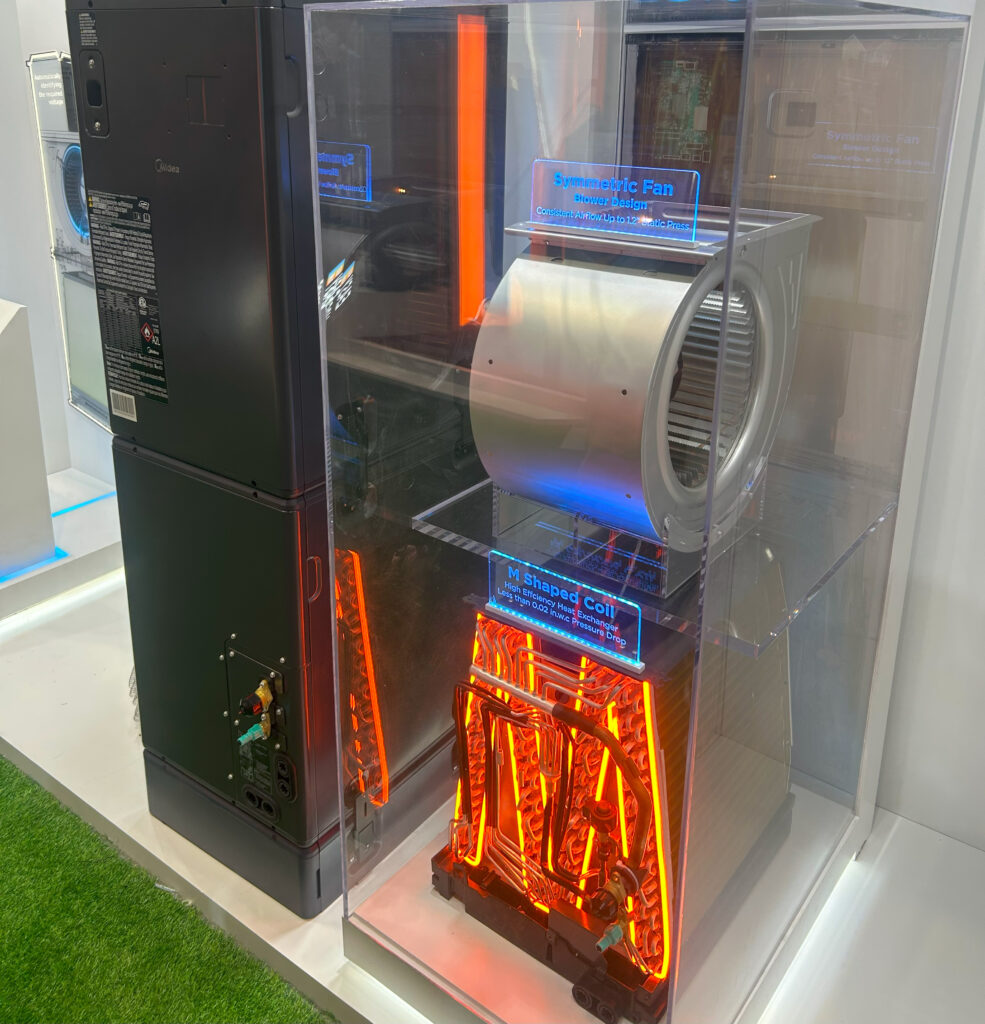
Caption: Shaped like an M, this coil in the Midea AirCube air handler is more efficient than A-coils, and can act as an additional source of heat if needed.
However, the technological innovations on display at AHR were not limited to heat pumps. For example, Electro Industries showed how their electric radiant heat boiler can work in tandem with a Bradford White heat pump water heat to efficiently heat a house by heating its floors rather than pumping warm air into the house—a particularly effective solution for people living in some of the coldest regions of the United States who want to keep their homes warm and cozy during long, harsh winters.
Rheem, A.O. Smith, LG, and other manufacturers also showcased heat pump water heaters alongside their heat pumps and other HVAC products. Rheem and A.O. Smith had new 120-volt heat pump water heaters on display, while LG showed off a sleek heat pump water heater, already popular in Europe, that is attractive enough to be displayed in a home’s kitchen rather than hidden in a closet somewhere.
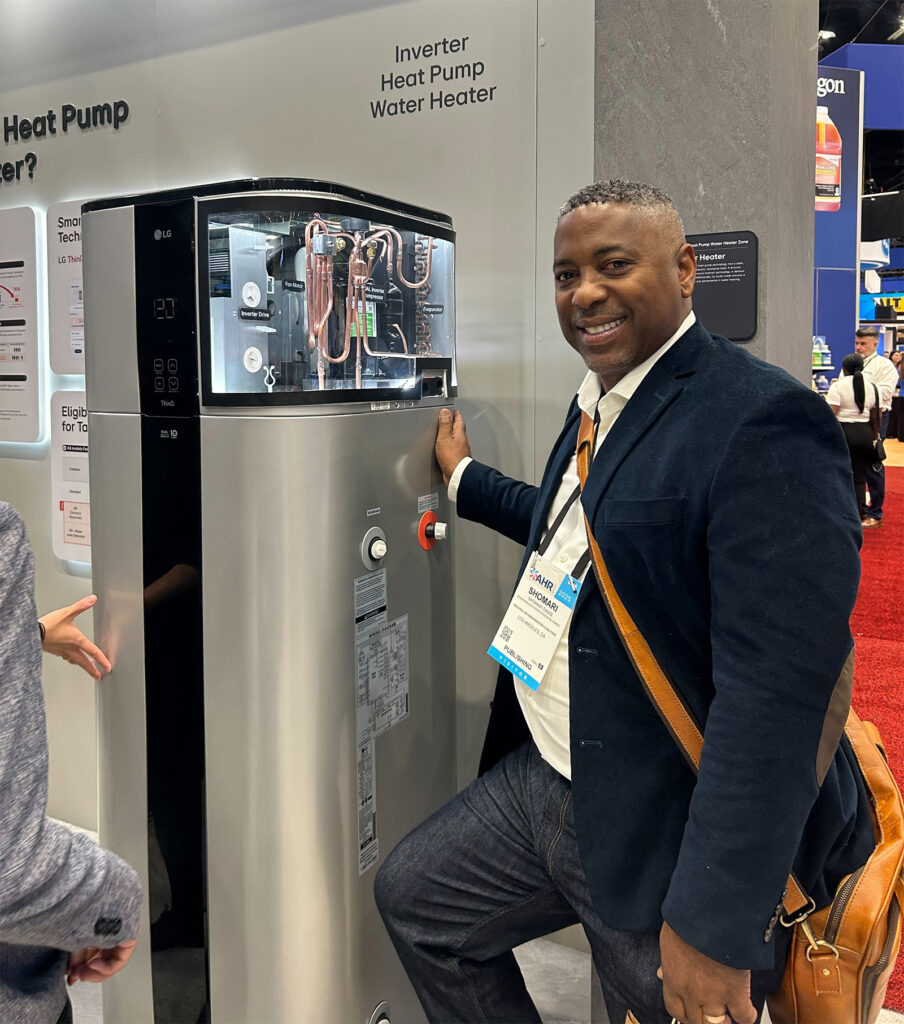
Caption: The author next to an LG heat pump designed to be installed and displayed in someone’s kitchen or other parts of their house, rather than hidden in a closet or basement.
Thermal Energy Networks Represent Another Emerging Market for Heat Pumps
Exhibits and the chatter we heard on the showroom floor indicate that the HVAC industry is also getting excited about a potentially huge new market for heat pump products—thermal energy networks (TENs). TENs network together multiple heat pumps with thermal energy sources (like geothermal boreholes or wastewater systems) to deliver clean heating and cooling to entire neighborhoods even more efficiently than heat pumps alone can. The first utility-owned thermal energy network in the United States was launched last year, and there are plans to develop dozens of more thermal energy networks across the United States. Seeking to tap into this market, Sharc Energy has developed products that enable a TEN’s heat pump to use the thermal energy generated by wastewater systems to heat buildings.
Meanwhile, the Climate Control Group displayed geothermal and other products for ground-source heat pumps (GSHPs) and TENs at their booth, and talked to me about the need to train the workers that will be needed to drill geothermal boreholes for this growing market. Interestingly enough, at the show I also met Brock Yordy, an experienced driller who taught an introductory class on drilling to residents from an underserved community in Boston. He told me he has told his students that TENs are one of the reasons why there are a growing number of career opportunities for those in the drilling trade.
Customer Preferences & Sales Point Toward Strong Continued Growth for Zero-Emission Heat in the HVAC Industry
As we walked through the conference, we did hear some concerns from manufacturers and contractors about the current and future status of the Inflation Reduction Act (IRA) and other federal heat pump incentives. That said, we also heard from them how many state governments are continuing to advance policies designed to increase the adoption of heat pumps.
In addition, the show demonstrated to us that, thanks to many of the technological innovations displayed at the conference, heat pumps are continuing to extend their advantage over fossil-fuel-powered furnaces when it comes to energy efficiency, flexibility, comfort, and maintenance—advantages that resulted in 90% of respondents to a recent survey who owned a heat pump saying they would recommend them to others.
Having been in the HVAC industry for years, this year’s AHR EXPO clearly demonstrated that it has turned a corner, with manufacturers and contractors gravitating more and more toward heat pumps. Today, the future of HVAC is electric.
